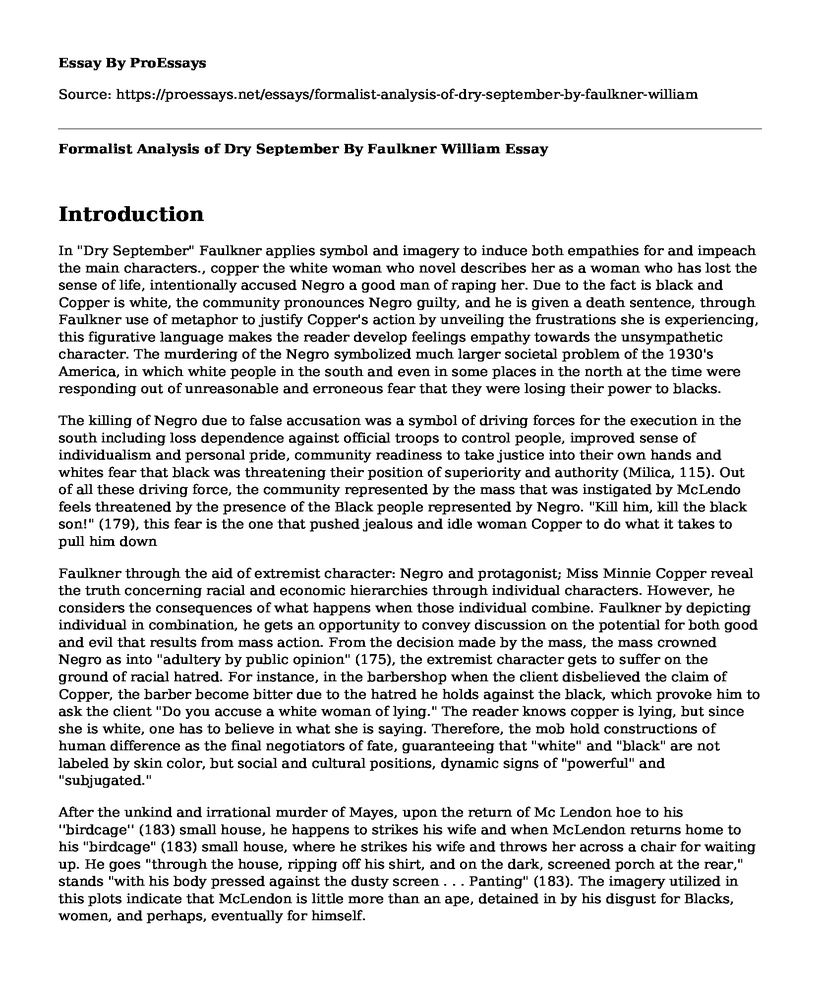Introduction
In "Dry September" Faulkner applies symbol and imagery to induce both empathies for and impeach the main characters., copper the white woman who novel describes her as a woman who has lost the sense of life, intentionally accused Negro a good man of raping her. Due to the fact is black and Copper is white, the community pronounces Negro guilty, and he is given a death sentence, through Faulkner use of metaphor to justify Copper's action by unveiling the frustrations she is experiencing, this figurative language makes the reader develop feelings empathy towards the unsympathetic character. The murdering of the Negro symbolized much larger societal problem of the 1930's America, in which white people in the south and even in some places in the north at the time were responding out of unreasonable and erroneous fear that they were losing their power to blacks.
The killing of Negro due to false accusation was a symbol of driving forces for the execution in the south including loss dependence against official troops to control people, improved sense of individualism and personal pride, community readiness to take justice into their own hands and whites fear that black was threatening their position of superiority and authority (Milica, 115). Out of all these driving force, the community represented by the mass that was instigated by McLendo feels threatened by the presence of the Black people represented by Negro. "Kill him, kill the black son!" (179), this fear is the one that pushed jealous and idle woman Copper to do what it takes to pull him down
Faulkner through the aid of extremist character: Negro and protagonist; Miss Minnie Copper reveal the truth concerning racial and economic hierarchies through individual characters. However, he considers the consequences of what happens when those individual combine. Faulkner by depicting individual in combination, he gets an opportunity to convey discussion on the potential for both good and evil that results from mass action. From the decision made by the mass, the mass crowned Negro as into "adultery by public opinion" (175), the extremist character gets to suffer on the ground of racial hatred. For instance, in the barbershop when the client disbelieved the claim of Copper, the barber become bitter due to the hatred he holds against the black, which provoke him to ask the client "Do you accuse a white woman of lying." The reader knows copper is lying, but since she is white, one has to believe in what she is saying. Therefore, the mob hold constructions of human difference as the final negotiators of fate, guaranteeing that "white" and "black" are not labeled by skin color, but social and cultural positions, dynamic signs of "powerful" and "subjugated."
After the unkind and irrational murder of Mayes, upon the return of Mc Lendon hoe to his ''birdcage'' (183) small house, he happens to strikes his wife and when McLendon returns home to his "birdcage" (183) small house, where he strikes his wife and throws her across a chair for waiting up. He goes "through the house, ripping off his shirt, and on the dark, screened porch at the rear," stands "with his body pressed against the dusty screen . . . Panting" (183). The imagery utilized in this plots indicate that McLendon is little more than an ape, detained in by his disgust for Blacks, women, and perhaps, eventually for himself.
Conclusion
"Dry September" is a story that its symbolic meaning is timeless and can be utilized to societies at any moment throughout history. The themes and symbols that have been raised throughout the novel, in my opinion, are not just applicable to the fictional town of the two characters happen to live but also denotation of what was trendy in the 1930's southern society and is even relevant to various features of the American society today.
Work Cited
Faulkner, William. "Dry September." Collected Stories (1934): 169-183.
Milica, Iulia Andreea. "Racial Violence in William Faulkner's Dry September and Harper Lee's to Kill a Mockingbird." Linguaculture 2012.1 (2012): 103-120.
Cite this page
Formalist Analysis of Dry September By Faulkner William. (2022, Jun 22). Retrieved from https://proessays.net/essays/formalist-analysis-of-dry-september-by-faulkner-william
If you are the original author of this essay and no longer wish to have it published on the ProEssays website, please click below to request its removal:
- The Girl on Train by Paula Hawkins Essay
- The Astronauts by Robert Hayden - Poetry Analysis Essay
- The Theme of Perseverance in "The Valley of Detachment"
- Tell-Tale Heart Compares to Scarlet Letter: Literary Analysis Essay
- "The Parable of the Sower" a Critical Analysis Essay
- Assignment Example on Death of a Salesman by Arthur Miller
- Essay Example on Death's Bitter Grip: Emily Dickinson's Immortality







